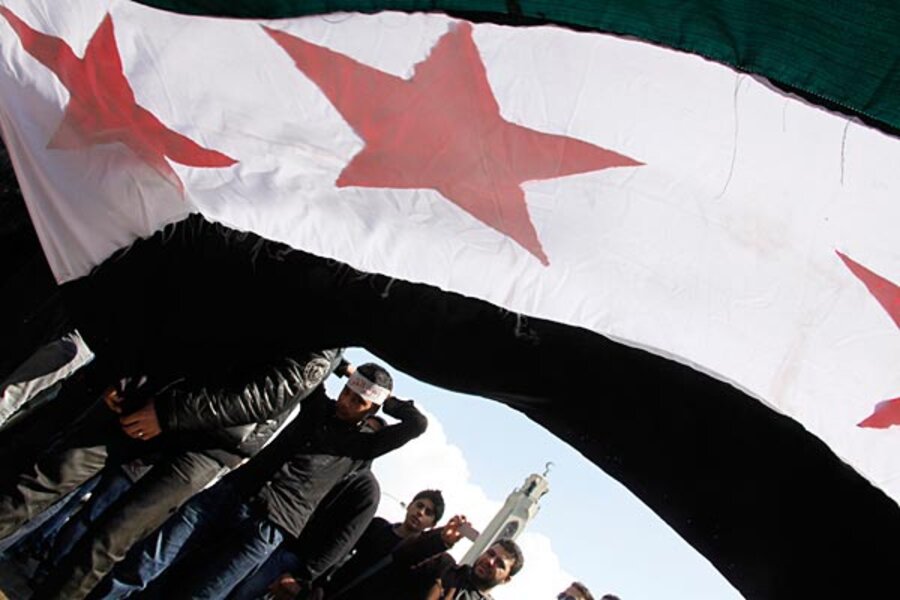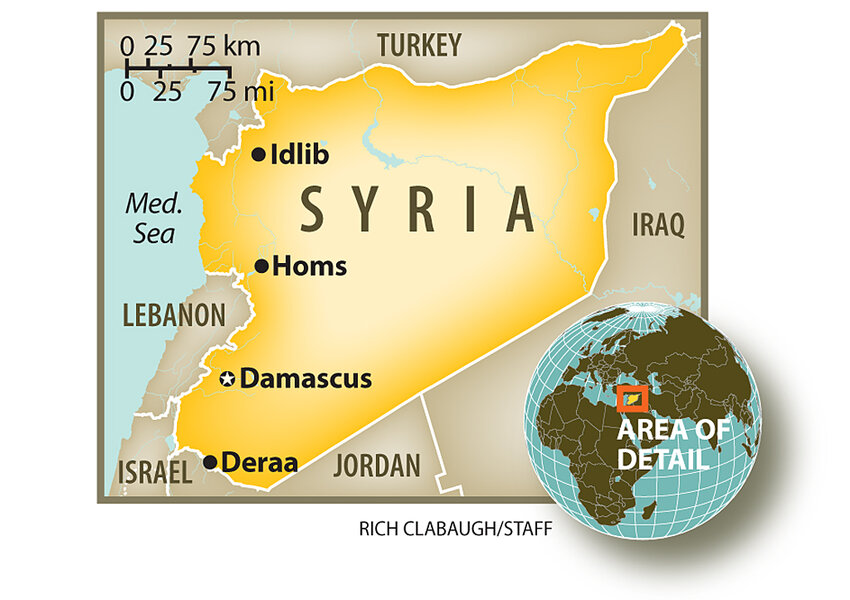Syria crisis causes Iran-led 'axis of resistance' to fray
Loading...
| Istanbul, Turkey
On the ground, Syria’s day-to-day revolt may look like any other Arab Spring revolution, with widespread protests against the dictatorial rule of President Bashar al-Assad, and powerful military and security forces trying to crush them.
But analysts say the Syrian crisis is already having a global strategic impact beyond that of the Arab world's other people-power uprisings, which brought down authoritarian rulers in Tunisia, Egypt, Libya, and Yemen.
As revolutionary turmoil in Syria enters its second year today – with more than 8,000 killed already – the crisis is rekindling US-Russia rivalry in the Middle East. It is also jeopardizing the Iran-led “axis of resistance" to Western interests in the region.
In keeping with the regional cold war that has been simmering here for years, Iran and the Shiite Hezbollah militia in Lebanon have fully supported their Syrian ally, while Sunni states friendly to the US, like Saudi Arabia and Qatar, have called for arming anti-Assad rebels.
But last month, a central member of the resistance axis – the Palestinian militant group Hamas – abruptly abandoned its longtime patron Syria and its leaders decamped to Egypt and Qatar.
Moreover, Syria's role in the resistance alliance is only as strong as Assad's rule. If he were forced out, Hezbollah's ready access to Iranian-supplied weapons could be severely reduced and therefore Iran's ability to maintain Hezbollah's potency as a proxy against Israel could diminish.
“This Syria-Iran-Hezbollah-Hamas ‘axis of resistance’ has started to fray, with Hamas essentially pulling out, and the Syrians being challenged at home, so this whole equation has to be reconsidered,” says Rami Khouri, a Mideast analyst at the American University of Beirut. “If the Syrian regime were to be changed, both Hezbollah and Iran would be dealt a blow.”
More broadly, the Syria crisis has engendered “a return of a global competition," says Mr. Khouri. Indeed, Russia and China – feeling burned by voting for a Libya resolution last year that turned into de facto regime change – have vetoed two United Nations Security Council resolutions on Syria, thwarting American and European attempts to take action against the Assad regime. Since then, Syrian forces have launched brutal assaults on key rebel strongholds, including Homs, Idlib, and Deraa.
"It was the Russian and Chinese veto that really gave the Syrians a special boost,” says Khouri. “The Russians are clearly pushing back against what they see as an American-dominated drive in the region, and Russians don’t want the Americans to go around changing regimes at will.”
High stakes
Kofi Annan, envoy for the United Nations and Arab League, is due to brief the UN Security Council today about his fruitless efforts so far to bring a cease-fire. His efforts have been vastly complicated by the regional gamesmanship.
“What has happened in the big picture is that the Syrian crisis has been caught in a regional cold war,” says Fawaz Gerges, head of the Middle East Center at the London School of Economics.
The regional battle lines were clearly drawn in the aftermath of the 2006 Israel-Hezbollah war, when the Shiite Hezbollah militia leader Sheikh Hassan Nasrallah declared a “divine victory” after a 33-day fight. Iran helped Hezbollah in that battle, channeling thousands of rockets and cash, in a war that both Tehran and Washington portrayed as a regional face-off.
“This whole resistance axis, it’s like a virtual front,” says Khouri. “It always had a certain shelf life; each party drew from it certain things that they benefited from.”
The stakes now for regional players like Iran are high. Gen. James Mattis, head of US Central Command, testified to Congress earlier this month that Iran was flying weapons and experts into Syria in "a full-throated effort ... to keep Assad there and oppressing his own people." When Assad falls, he said, "it'll be the biggest strategic setback for Iran in 20 years."
“For sure the Iranians will help the Syrian regime stay in power, because the Syrian connection is one of their few foreign policy successes in the Arab world; the other is Hezbollah,” says Khouri.
The stakes are also high for Russia, which has $5 billion in weapons contracts with the Syrian regime and has taken an international stand against intervention – a stance informed in part with its own turbulent history of revolutions.
At an Arab League meeting in Cairo last week, Russian Foreign Minister Sergei Lavrov defended the Syrian regime, and cast Russia’s support as protecting “international law.”
But Arab foreign ministers, especially from Saudi Arabia and Qatar, were withering in their response, with Saud al-Faisal of Saudi Arabia rejecting “hollow resolutions and … spineless positions.”
Such a lack of international consensus, together with divisions among the various Syrian opposition groups and the rebels' inability to secure adequate weapons for the Free Syrian Army, helps explains why Syria has so far proven to be the longest and most deadly Arab popular uprising.
Those regional and international variables complicate the Syrian crisis, in contrast to Libya last spring, where there was consensus on a decision against Muammar Qaddafi on the Security Council.
“In the case of Assad, what is really surprising are the two double vetoes, by two of the greatest powers in the international system. This is big news,” says Gerges. “Even Russia said, ‘Any cease-fire must be mutual [between the regime and the rebels].' "
Musical chairs
While most analysts predict Assad’s eventual downfall – noting that Syrians have not been deterred from taking to the streets after a year of brutal violence against them, in their bid to end 40 years of Assad-family rule – few are willing to hazard a guess about when that may be.
Iran, which remembers that the Syrian president’s father, Hafez al-Assad, was the one Arab leader who stood alongside it during the Iran-Iraq war of the 1980s, has thrown its full support behind Syria – not least of all because this Syrian regime plays a key role in its regional strategy.
The prospect of an eventual regime collapse in Syria is already resonating in Tehran.
Iranian leaders have proclaimed their support of Arab uprisings against pro-Western “tyranny” as part of a broader “Islamic awakening” that they claim is a natural extension of Iran’s own 1979 Islamic revolution. But pointedly not among the list of those Iran-recognized “awakenings” is Syria, which Iran claims is different, and the subject of manipulation and “sedition” by Western and Israeli “enemies.”
Today, the Syrian revolution is redefining longstanding power balances, and injecting yet more uncertainty into the Middle East. “Transitions” are under way in Russia and Iran, says Khouri, that make outcomes even more unpredictable.
“Everybody’s in flux, all the players in the region and international ones, the US itself it getting out of the region slowly and losing impact,” notes Khouri. “It’s like musical chairs: Everybody’s on the move, and it's going to take some years for everything to settle down.”







